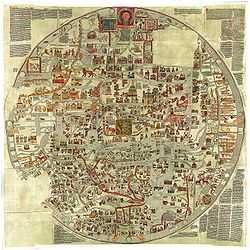Ebstorf Map

The Ebstorf Map is an example of a mappa mundi (a Medieval European map of the world) similar to the Hereford Map. It was made by Gervase of Ebstorf, who was possibly the same man as Gervase of Tilbury,[1] some time in the thirteenth century.
The map was found in a convent in Ebstorf, in northern Germany, in 1843.[2] It was a very large map, painted on 30 goatskins sewn together and measuring around 3.6 by 3.6 metres (12 ft × 12 ft)—a greatly elaborated version of the common medieval tripartite, or T and O, map, centered on Jerusalem with east at top. The head of Christ was depicted at the top of the map, with his hands on either side and his feet at the bottom.[3] Rome is represented in the shape of a lion, and the map reflects an evident interest in the distribution of bishoprics.[1]
There was text around the map, which included descriptions of animals, the creation of the world, definitions of terms, and a sketch of the more common sort of T and O map with an explanation of how the world is divided into three parts. The map incorporated both pagan and biblical history.[3]
The arguments for Gervase of Tilbury's being the mapmaker are based on the name Gervase, which was an uncommon name in Northern Germany at the time, and on some similarities between the world views of the mapmaker and Gervase of Tilbury. The editors of the Oxford Medieval Texts edition of Gervase of Tilbury's Otia Imperialia conclude that although their being the same man is an "attractive possibility", to accept it requires "too many improbable assumptions".[1]
The original was destroyed in 1943, during the bombing of Hanover in World War II. There survives a set of black-and-white photographs of the original map, taken in 1891, and several color facsimiles of it were made before it was destroyed.[3]
Notes
- ↑ 1.0 1.1 1.2 S. E. Banks and J. W. Binns, eds., Otia Imperialia by Gervase of Tilbury, Oxford Medieval Texts (Oxford: Oxford University Press, 2002), pp. xxxiv–xxxvi.
- ↑ Bettina Bildhauer, "Blood, Jews and Monsters", in The Monstrous Middle-Ages, ed. Bettina Bildhauer and Robert Mills (Cardiff: University of Wales Press, 2003), p. 77.
- ↑ 3.0 3.1 3.2 Evelyn Edson, Mapping Time and Space: How Medieval Mapmakers Viewed Their World (London: British Library, 1997), pp. 138–139.
External links
- Higher quality image of the map
- Detailed description of the map
- Visual Encyclopaedias: The Hereford and other Mappae Mundi